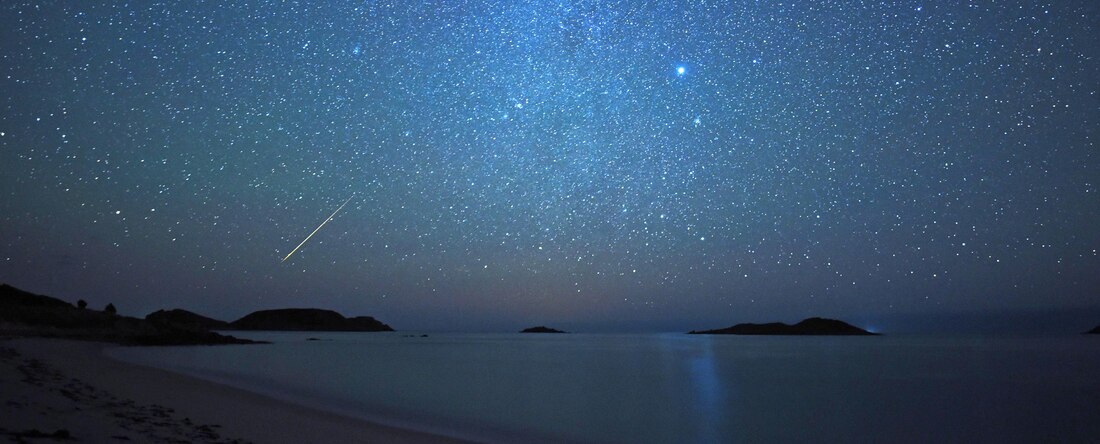 St Martin's resident Bruce Frank's picture of a Perseid meteor shooting over the Eastern Isles, taken in 2017 St Martin's resident Bruce Frank's picture of a Perseid meteor shooting over the Eastern Isles, taken in 2017 A version of this piece was originally broadcast on Radio Scilly in August 2019. We’ve had lots of lovely visitors to our observatory over the last couple of weeks, and thankfully the skies are getting just that little bit darker, so that now by 10pm you’ve got a good selection of stars and planets to ogle at. This week we enjoyed a great session looking at the first-quarter Moon through our two biggest telescopes and spotting Jupiter and Saturn along the ecliptic. Remember that it’s the busiest time of year here on Scilly and our sessions have proven to be very popular, so we do recommend you booking in advance, particularly for evenings, if you’d like to visit us in person. The star event this week is not a star but the Perseids. The annual Perseid meteor shower reaches its peak on the night of the 12th August this year. If the weather plays fair with us, you should be able to see up to 70 shooting stars per hour, streaking across our skies. However we will be subject to a bright Moon causing us some light pollution, which will drown out the fainter ones. Don’t let this put you off though – the Perseid meteor shower is one of the best and most loved meteor showers in the northern hemisphere, for good reason. These meteors can be spectacular. You don’t have to wait until Monday night to spot Perseids. We tend to focus on the peak of activity, entirely reasonable, but actually Perseids have been streaking across our sky since about the 17th July, and activity has ramped up from the beginning of August. You might have even seen some already! The Perseids tend to take a while to build up to a peak before falling off sharply – though we’ll still see them up to 10 days after the peak of activity on the 12th. So what do they look like and why are they so special? Perseid meteors are particularly bright and fast with lovely long trails. It’s one of the most active meteor showers of the whole year. There’s a particularly high chance of seeing fireballs – very bright meteors – as well. While they can be seen streaking across any part of the sky, they seem to radiate – or come from – within the constellation of Perseus, or, to my mind and somewhat easier to spot, below the wonky W of Cassiopeia. Meteors in these annual showers come from streams of debris left behind in space, by comets. In this case, that’s Comet Swift Tuttle. As our planet Earth crosses the orbital path of Comet Swift Tuttle, bits of the comet’s debris slam into our Earth’s upper atmosphere at an average speed of 36 miles per second, burning up on impact. This force of energy causes quite the night-time light show from these fast-moving meteors. And how best to view the Perseids? The good news is that you don’t need any special equipment or knowledge of the constellations! Get yourself to a spot where you’ve got dark, open sky. Open sky is essential because these meteors fly across the sky in many directions and in front of lots of different constellations. On Scilly, finding dark and open sky is an easy one, but you’ll still want to take yourself away from any outdoor lighting or glare from house lights. You might want to lie on the grass - or beach - or get yourself a nice reclining deck chair with a blanket! The weather for the peak of the activity this year is looking variable, though we may be lucky enough to snatch some cloud-free moments. The best time to look is towards midnight and after, when the chances of seeing increase. However, meteors are part of nature and there’s no way to predict how many you’ll see during any given period. Be patient. In any case, to get the best of it, give yourself at least an hour of observing time – and remember your eyes can take up to 20 minutes to adjust to the dark. Perseids can come in fits and starts and good things come to those who wait. Find yourself a good spot and relax – you’ll see some. Let us know how you get on – and remember you can share any photos on our COSMOS Facebook group or email them to me at [email protected]. Enjoy those shooting stars!
0 Comments
Your comment will be posted after it is approved.
Leave a Reply. |
BYCharlie Payne POSTS
September 2024
|

 RSS Feed
RSS Feed